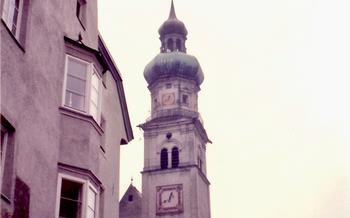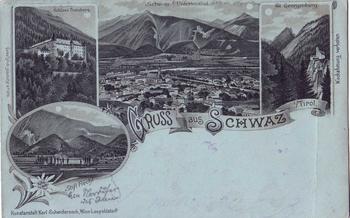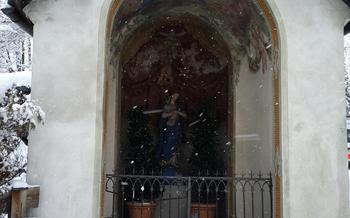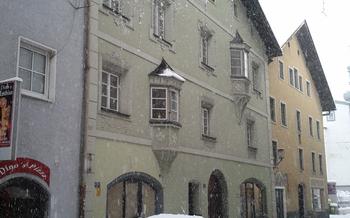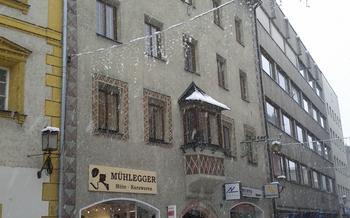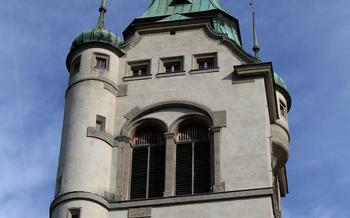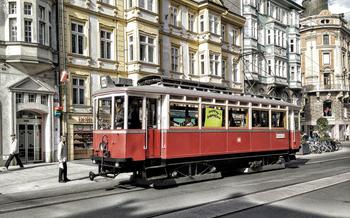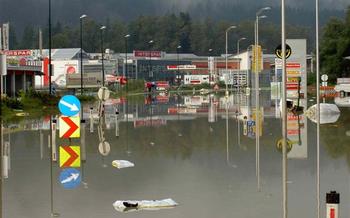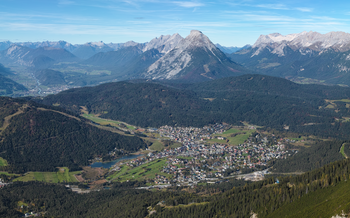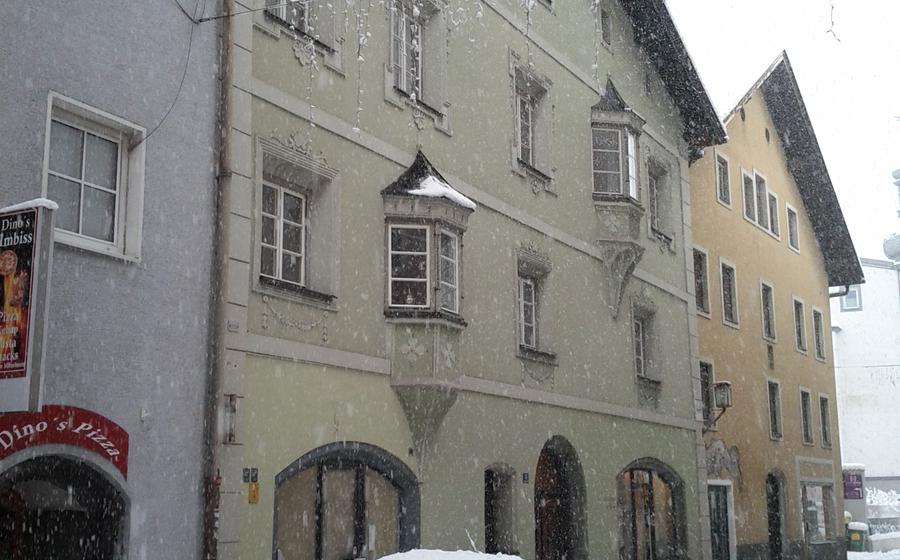
Gurgltal Miners' World
- History of the Gurgltal Miners' World
- Museum Highlights
- Guided Tours
- The Mining Village of Silbertal
- The Mines' Natural Setting
- The Mining Museum Outdoor Area
- The "Knappenkapelle" Miners' Chapel
- The "Knappenstube" Miners' Pub
- The "Knappenmarkt" Miners' Market
- The "Knappenfest" Miners' Festival
- The "Knappenmuseum" Miners' Museum in Schwaz
- The "Silberbergwerk Schwaz" Silver Mine in Schwaz
- Insider Tip: Experience the Miners' Festival
History of the Gurgltal Miners' World
The Gurgltal valley, nestled in the heart of the Tyrolean Alps, boasts a rich and fascinating mining history dating back to the Middle Ages. The discovery of silver, copper, and lead ores in the valley's mountains led to the establishment of numerous mines, transforming the region into a hub of mining activity. In the 15th century, the Schwaz silver mine, located near the valley, gained prominence as one of the most productive silver mines in Europe, contributing significantly to the wealth and prosperity of the region.
However, mining in the Gurgltal valley was not without its challenges. The miners faced harsh working conditions, toiling deep underground in narrow tunnels, battling darkness, humidity, and the constant threat of cave-ins. Ventilation was poor, and the air was often filled with toxic fumes. The miners also risked contracting diseases such as silicosis from inhaling rock dust. Despite these hardships, they persevered, driven by the allure of the riches that lay beneath the earth's surface.
In the 19th century, the mining industry in the Gurgltal valley began to decline due to the depletion of ore reserves and the introduction of more efficient mining techniques in other regions. As a result, many of the mines were forced to close, leaving behind a legacy of abandoned mines and mining settlements. Today, the Gurgltal Miners' World preserves this rich heritage, inviting visitors to step back in time and explore the fascinating world of mining in the Tyrolean Alps.
Museum Highlights
The Gurgltal Miners' World Museum boasts a treasure trove of fascinating exhibits that bring the history and traditions of mining in the valley to life. Visitors can marvel at the intricate mining tools and equipment used by miners over the centuries, from pickaxes and shovels to lamps and helmets. Interactive displays provide immersive insights into the miners' lives, showcasing their daily routines, challenges, and triumphs. The highlight of the museum is a meticulously recreated mine tunnel, where visitors can experience the claustrophobic and dimly lit conditions faced by the miners as they extracted valuable ores from the depths of the earth.
Guided Tours
The Gurgltal Miners' World offers guided tours led by former miners, providing visitors with an immersive and informative experience. These knowledgeable guides share their firsthand insights into the mining processes and the history of the mines. Visitors can ask questions and gain a deeper understanding of the miners' world.
The guided tours allow visitors to explore areas of the mines that are not accessible to the general public, providing a unique perspective on the mining operations. These tours offer a glimpse into the challenging and dangerous conditions that the miners faced, as well as the ingenuity and perseverance they displayed in extracting valuable ores from the earth.
For those seeking a truly authentic experience, the guided tours are an excellent way to learn about the rich mining heritage of the Gurgltal valley and to appreciate the significant role that mining played in shaping the region's history and culture.
The Mining Village of Silbertal
Nestled at the foot of the majestic Tyrolean Alps, the charming village of Silbertal exudes an aura of history and tradition, deeply rooted in its mining heritage. Once a thriving mining settlement, Silbertal's past is still palpable in its preserved miners' houses and buildings, showcasing the traditional Tyrolean architecture that reflects the village's rich legacy. Here, visitors can immerse themselves in the local culture, savor the authentic Tyrolean cuisine, and experience the warm hospitality of the locals, who proudly keep the mining traditions alive.
The Mines' Natural Setting
The Gurgltal valley is a stunning alpine paradise, providing a breathtaking backdrop to the Gurgltal Miners' World. Surrounded by lush forests, towering mountains, and pristine lakes, the valley offers a feast for the eyes with its natural beauty. Visitors can embark on scenic hiking trails, leading them through enchanting forests and up to panoramic viewpoints that unveil breathtaking vistas of the valley and the surrounding peaks. The abundance of wildlife, including marmots, ibex, and eagles, adds to the charm of the natural setting, making it a haven for nature enthusiasts.
The Mining Museum Outdoor Area
The outdoor area of the Gurgltal Miners' World is a fascinating extension of the museum, offering visitors a deeper insight into the practical aspects of mining. Here, you can explore an array of mining machinery and equipment, such as ore carts, waterwheels, and compressors, which played a crucial role in the mining operations.
One of the highlights of the outdoor area is the opportunity to explore the miners' water management system. This intricate network of channels, reservoirs, and aqueducts was essential for providing water power to the mines and for draining the underground tunnels. Visitors can trace the flow of water through the system and gain an understanding of the engineering ingenuity of the miners.
Furthermore, the outdoor area showcases a collection of historic mining buildings, each representing a different aspect of the mining process. These include an ore house, a smithy, and a carpenter's workshop, where visitors can learn about the various tasks and crafts that were essential to the success of the mines.
To enhance the experience, the outdoor area often hosts demonstrations of traditional mining techniques, providing visitors with a glimpse into the arduous work and expertise required in this industry. These demonstrations bring the history of mining to life and offer a unique opportunity to witness the skills and knowledge of the miners firsthand.
The "Knappenkapelle" Miners' Chapel
In the heart of the Gurgltal valley, nestled among the towering mountains, stands the "Knappenkapelle", a small and unassuming chapel built by the miners in the 16th century. This sacred place served as a sanctuary for the miners, where they could seek solace and pray for protection during their perilous work.
The chapel's interior is adorned with beautiful frescoes depicting scenes from the miners' lives, their struggles, and their deep faith. The altar is dedicated to Saint Barbara, the patron saint of miners, who is revered for her protection against accidents and sudden death.
Visiting the "Knappenkapelle" offers a glimpse into the miners' religious beliefs and traditions. It is a place of quiet contemplation, where one can pay homage to the miners' courage and resilience and appreciate the deep-rooted spirituality that sustained them through their arduous work.
The "Knappenstube" Miners' Pub
In the heart of the Gurgltal valley, nestled amidst the towering mountains, lies the "Knappenstube" miners' pub. Steeped in history and tradition, this cozy establishment has served as a gathering place for miners for centuries. After a hard day's work in the mines, the miners would flock to the pub to quench their thirst, share stories, and celebrate their camaraderie.
As you step into the "Knappenstube," you are transported back in time. The warm glow of the fireplace illuminates the wooden walls adorned with mining tools and artifacts. The air is filled with the sound of laughter and conversation as locals and visitors alike mingle and share stories.
At the bar, you can sample a variety of local Tyrolean beers and schnapps, as well as traditional dishes that have been passed down through generations. The menu features hearty fare such as "Käsespätzle" (cheese spaetzle), "Tiroler Gröstl" (fried potatoes with meat and onions), and "Kaiserschmarrn" (shredded pancake with powdered sugar and fruit compote).
As you savor your meal, strike up a conversation with the friendly locals or former miners who frequent the pub. They will gladly share their stories and experiences, providing you with a glimpse into the fascinating world of mining and the deep-rooted traditions of the Gurgltal valley.
The "Knappenstube" is more than just a pub; it is a living testament to the rich mining heritage of the region. It is a place where the past and present intertwine, creating a unique and unforgettable atmosphere. So, whether you are a history buff, a beer enthusiast, or simply looking for a cozy place to relax and soak up the local culture, the "Knappenstube" miners' pub is a must-visit destination.
The "Knappenmarkt" Miners' Market
The "Knappenmarkt," or Miners' Market, is an annual event held in the charming village of Silbertal, nestled in the heart of the Gurgltal valley. This vibrant market celebrates the rich mining heritage of the region and offers a unique opportunity to immerse yourself in the local culture.
Every year, on the first Sunday in August, Silbertal transforms into a bustling marketplace, where vendors from near and far gather to showcase their wares. Stalls adorned with traditional Tyrolean decorations line the cobblestone streets, creating a festive atmosphere that draws visitors from all around.
At the Knappenmarkt, you can browse a wide array of traditional crafts, local produce, and mining-related souvenirs. Skilled artisans display their handmade goods, from intricate wood carvings and pottery to delicate lace and textiles. Farmers from the surrounding villages sell fresh fruits, vegetables, and cheeses, while local businesses offer a variety of specialty products, such as honey, jams, and schnapps.
In addition to the market stalls, the Knappenmarkt features live music, dancing, and other festivities. Local musicians entertain the crowds with traditional Tyrolean tunes, while dancers perform in colorful costumes. There are also plenty of activities for children, such as face painting, games, and pony rides.
The Knappenmarkt is a wonderful opportunity to experience the vibrant culture of the Gurgltal valley and learn more about its rich mining history. As you stroll through the market, you can admire the beautiful surroundings and chat with the friendly locals, who are always happy to share stories and traditions.
So, mark your calendar for the first Sunday in August and join the festivities at the Knappenmarkt in Silbertal. Immerse yourself in the unique atmosphere of this traditional Tyrolean market, celebrate the region's mining heritage, and take home a piece of the Gurgltal valley with you.
The "Knappenfest" Miners' Festival
The "Knappenfest," or Miners' Festival, is a vibrant and traditional event held annually in the Gurgltal valley to honor the patron saint of miners, Saint Barbara. This colorful festival showcases the deep-rooted customs and heritage of the mining community. During the festival, the streets of Silbertal come alive with colorful processions, traditional costumes, and a festive atmosphere. The miners, dressed in their finest Tyrolean attire, parade through the village, carrying lanterns and singing traditional songs. The highlight of the festival is the blessing of the miners and their tools by a local priest, symbolizing the community's gratitude for their hard work and dedication. Visitors to the festival can immerse themselves in the vibrant Tyrolean culture, enjoy live music and dancing, and sample local culinary delights. The "Knappenfest" is a unique opportunity to witness the deep-rooted traditions of the Gurgltal mining community and celebrate the important role that mining has played in shaping the region's history and identity.
The "Knappenmuseum" Miners' Museum in Schwaz
Nestled in the heart of Schwaz, the "Knappenmuseum" Miners' Museum stands as a testament to the town's rich mining heritage. This comprehensive museum offers a fascinating journey into the world of the miners who once toiled in the depths of the surrounding mountains.
Inside the museum, visitors are greeted by a treasure-trove of exhibits that bring to life the story of Schwaz's mining past. From ancient mining techniques to the tools and equipment used by the miners, the museum provides a comprehensive overview of the industry that shaped the town's history.
Interactive displays add an engaging element to the museum's exhibits, allowing visitors to delve deeper into the lives and working conditions of the miners. Through these interactive experiences, visitors can gain a firsthand understanding of the challenges and hardships faced by those who worked in the mines.
The museum also highlights the significance of mining to the development of Schwaz. From its humble beginnings as a small mining settlement to its rise as a prosperous silver mining town, the museum traces the town's transformation and growth through the lens of its mining industry.
A visit to the "Knappenmuseum" Miners' Museum is a must for anyone interested in the history of mining and its impact on the development of Schwaz. The museum's rich collection of exhibits, interactive displays, and informative panels provide a comprehensive and engaging experience that will leave visitors with a deep appreciation for the miners' legacy and its enduring impact on the town.
The "Silberbergwerk Schwaz" Silver Mine in Schwaz
The "Silberbergwerk Schwaz" silver mine in Schwaz is a fascinating attraction that offers a glimpse into the rich mining history of the region. Visitors can embark on guided tours that take them through the underground tunnels and chambers, where they can learn about the mining techniques and equipment used in the past. The mine showcases displays of mining artifacts and machinery, providing a deeper understanding of the challenges faced by the miners and the significance of silver mining to the development of Schwaz. Exploring this historic mine is a must for anyone interested in mining history and culture.
Insider Tip: Experience the Miners' Festival
To truly immerse yourself in the rich mining heritage of the Gurgltal valley, plan your visit during the annual "Knappenfest" (Miners' Festival), held in November. This vibrant festival honors the patron saint of miners, Saint Barbara, and features colorful processions, traditional costumes, and a festive atmosphere. Witness the blessing of the miners and their tools, and experience the deep-rooted traditions of the mining community firsthand. The festival is a unique opportunity to celebrate the legacy of mining in the Gurgltal valley and gain a deeper appreciation for the hard work and dedication of the miners who shaped its history.
